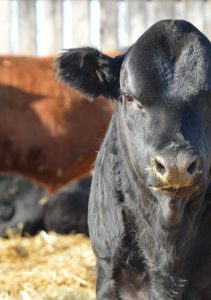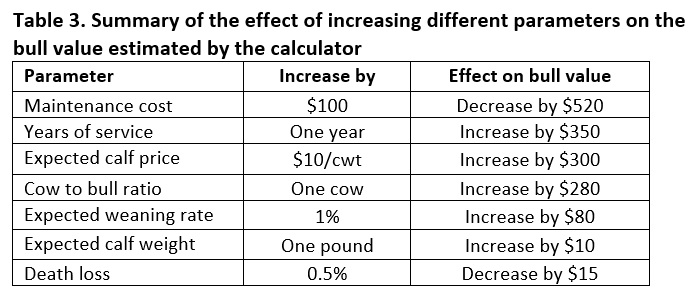Bull Selection: New Calculator to Determine the Value of a Bull

Editor’s note: The following is part four of a four-part series that helps you to evaluate different breeding programs, which bulls are optimal for your herd, and how much they’re worth. (See part one, part two and part three).
Different traits of bulls can contribute to different impacts on the bottom line of the operation. For example, a bull with a higher calving ease EPD may contribute to more live calves. Not surprisingly, bulls with higher calving ease (or lower birth weights) sell for a higher price (Simms et al., 1997). With the large variation in bulls available, bull prices extend over a wide range from $3,000 to over $20,000 per head.
Identifying a fair price during sire selection contributes to higher efficiency in operation economics. To estimate breakeven bull price, a bull valuation calculator has been developed. The purpose is to provide a general idea of how much a bull is worth based on key farm parameters.
Bull Values – Two Scenarios
The value a bull provides depends on his individual performance, the environment (ex: pasture productivity), management (cow:bull ratio) and markets (calf price). For example, large framed bulls require more feed, leading to a higher maintenance cost, but that may be offset by heavier calves at sale time.
Two scenarios were studied – a low maintenance farm versus a high maintenance farm. Table 1 shows the parameters entered for each farm. The default values in the calculator are the averages of the two scenarios.
The low maintenance farm is assumed to have a larger pasture size reducing the cow to bull ratio, multiple bulls in a field with potential for fighting as well as rough terrain contributing to reduced bull longevity, and reduced feeding costs over fewer days, resulting in lower maintenance costs. This management style is reflected in the cow herd as well with a lower weaning rate and lower weaning weights.
The high maintenance farm is assumed to have smaller breeding pastures, more labour, and more feed, which leads to a higher cow to bull ratio, greater longevity, higher weaning rates, and higher weaning weights.

Despite keeping key parameters constant like the proportion of the calf value attributed to the bull and expected calf price, there is a large variation in bull value between the two farm scenarios (Table 2).

The high maintenance farm has a breakeven bull price more than double that of the low maintenance farm. In fact, the low maintenance farm would have had a much lower breakeven price if the annual maintenance cost was similar to the high maintenance farm. However, the lower annual maintenance cost helped to offset the lower cow to bull ratio and lower weaning rate.
For the high maintenance farm, the producer can afford to pay more for a bull given the expected performance of both the bull and its offspring. The large variation in bull prices on the market reflects the different abilities of the bull to bring value to an operation. This is impacted not only by the bull but also the environment and management system used by differing operations.
Driving Factors of Bull Price
The value a bull provides is in the calves sired over a lifetime, the long-term genetic change of the herd, and salvage value at the end of a productive life. (As long-term genetic change is not readily measurable by producers, this parameter was excluded from the calculator.)
The value provided depends on:
- cost factors (i.e., bull maintenance cost and death loss),
- performance factors (i.e., years of service, the expected cow to bull ratio, expected weaning rate, expected weight of feeders, and proportion of the calf value attributed to the bull), and
- price factors (i.e., expected price of feeders and salvage value).

Visit the Bull Valuation Calculator Web Page
**Download the Excel calculator here**
Learn More:
- Bull Valuation (Canfax Research Services Fact Sheet)
- BCRC Interactive Calculators (Decision Making Tools)
Click here to subscribe to the BCRC Blog and receive email notifications when new content is posted.
The sharing or reprinting of BCRC Blog articles is welcome and encouraged. Please provide acknowledgement to the Beef Cattle Research Council, list the website address, www.BeefResearch.ca, and let us know you chose to share the article by emailing us at info@beefresearch.ca.
We welcome your questions, comments and suggestions. Contact us directly or generate public discussion by posting your thoughts below.